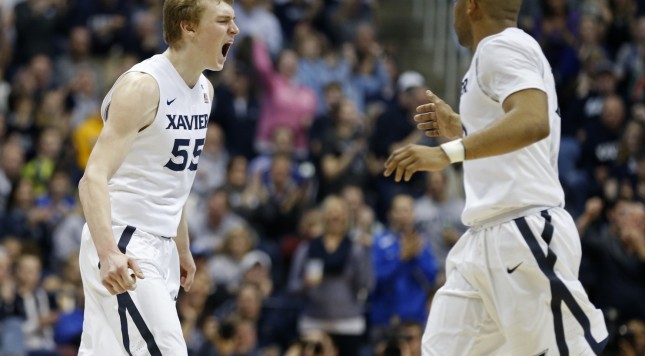College sports represent an analytical battleground for many reasons, chief among them the smaller sample sizes created by comparatively shorter regular seasons.
It’s true that college basketball features a 30-game regular season, two and a half times the length of a football campaign. Yet, an 18-game conference season combined with 12 non-conference clashes — all with relatively limited flexibility in terms of discretionary scheduling for the little guys — does not represent the picture of a robust statistical sample. It’s better than football, but football sets the bar at a pretty low level.
Because of the small-sample-size dynamic which is always present in college sports, fans and pundits are always going to argue about certain tension points. You’ll read about many of them in the coming weeks, on the road to the Final Four. Today’s tension point: Which kind of conference composition better reveals (or hides) a team’s true quality — the conference with a small number of heavyweights and a mushy, broad middle, or the more balanced and competitive conference with a larger top tier and a smaller middle class?
Two teams which illustrate this tension point — and will put it to the test in the coming weeks — are Xavier of the Big East and Chattanooga of the Southern Conference. Human beings are allowed to think highly or negatively of both teams, but anyone who views the two teams on a similar level — for better or worse — cannot make claims about conference strength. That claim can only be made by people who think highly of one team in the X-versus-Chattanooga comparison, and view the other with a lot more skepticism.
*
This past weekend, Xavier moved to 12-3 in the Big East and 24-3 overall with a win over Georgetown. The Musketeers are one of only four three-loss teams left in Division I hoops (with Arkansas-Little Rock, Hawaii, and Villanova). Chattanooga was ambushed at home by UNC-Greensboro, falling to 13-3 in the Southern Conference and 24-5 overall. The loss dealt a severe blow to the Mocs’ at-large hopes, but that’s another conversation for another time. The issue being discussed here is how a conference masks or reveals a team’s quality. Xavier and Chattanooga, both excellent in their conferences, occupy different pieces of turf.
If you look at the Big East and the SoCon, you’ll see two fundamentally different architectures of power: In the Big East, it’s Villanova and Xavier and then everyone else. X and Nova stand above the rest of the Big East. Six teams are fairly closely grouped in the middle, followed by DePaul and St. John’s at the bottom. In the SoCon, Chattanooga has been pushed by three teams which have at least 11 conference wins: East Tennessee State, Furman, and Wofford. Three teams are 8-8 in the league’s small middle section, followed by three teams in the bottom tier, all with 13 conference losses entering play on Monday, February 22.
If you’re convinced Xavier is good and Chattanooga is overrated, you’re very realistically thinking that the separation attained by Xavier relative to every non-Villanova team in the Big East is fairly impressive. This might be a generalization which needs to be unpacked and elaborated on the margins, but the fundamental core of the point remains intact.
Chattanooga, by failing to gain separation from the rest of the SoCon, could very well be seen as a less imposing and authoritative team within its own sphere of competition. (No one’s saying or suggesting that the Big East and SoCon exist, or should exist, on the same plane.)
If you think Xavier is oversold and Chattanooga is underappreciated, you might very reasonably conclude that the Musketeers are so far ahead of eight other Big East teams precisely because the conference has too many so-so schools. Sunday’s messy, cluttered, and hard-to-understand endgame sequence in the Seton Hall-St. John’s game underscored, for many, how lackluster the Big East is when X and Nova aren’t in the discussion. The inability of the league’s third- through sixth-place teams to make authoritative statements in February could be viewed as the primary reason Xavier is in position to get a No. 2 seed in the NCAA tournament.
Conversely, Chattanooga has been pushed and tested by three teams, whereas Xavier only has Villanova as a particularly formidable competitor in its own conference. The reality of having to play under additional levels of standings-based pressure during the season could make Chattanooga’s achievements more noteworthy within a smaller scope of observation. The loss to UNC-Greensboro was an awful one, but it could be considered part of the strain of trying to fend off three close pursuers in a conference race the Mocs are still very likely to win. Due to a sweep of East Tennessee State, Chattanooga will clinch the top seed for the SoCon tournament with just one victory later this week.
Will Xavier show that its best regular season in the Chris Mack era transcended the Big East… or that it was the product of the league’s mushy middle?
Will Chattanooga show in the coming weeks that vigorous competition is exactly what it needed to be at its best come tournament time, or will the Mocs’ narrow victory in the SoCon race (assuming it happens later in the week) point to vulnerabilities a 24-5 overall record simply doesn’t indicate?
We’re all about to find out.
Those who are equally impressed by — or skeptical of — the Musketeers and Mocs are not at risk of being intellectually exposed.
Those who are selling stock for one of these teams and are buying stock for the other? They’re (likely) about to be proved wrong in one way or another.

